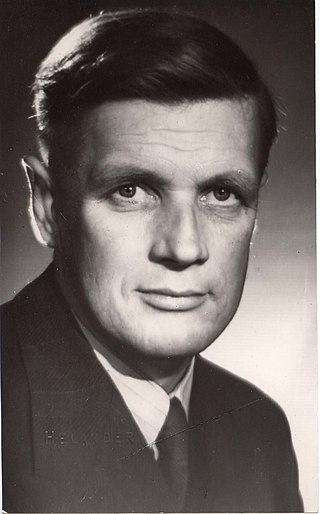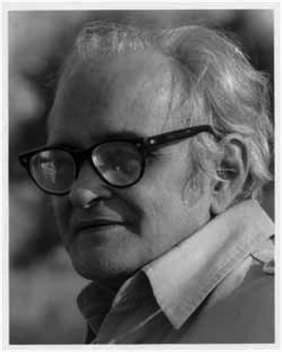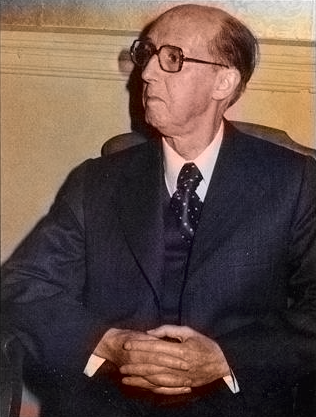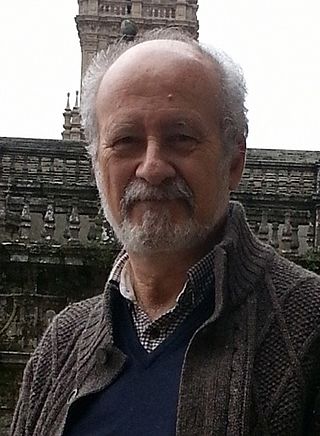Related Research Articles
Manuel de Falla y Matheu was a Spanish composer and pianist. Along with Isaac Albéniz, Francisco Tárrega, and Enrique Granados, he was one of Spain's most important musicians of the first half of the 20th century. He has a claim to being Spain's greatest composer of the 20th century, although the number of pieces he composed was relatively modest.

Joaquín Turina Pérez was a Spanish composer of classical music.

Robert Gerhard i Ottenwaelder was a Spanish and British composer, musical scholar, and writer, generally known outside his native region of Catalonia as Roberto Gerhard.

Uuno (Kalervo) Klami was a Finnish composer of the modern period. He is widely recognized as one of the most significant Finnish composers to emerge from the generation that followed Jean Sibelius.
Cristóbal Halffter Jiménez-Encina was a Spanish classical composer. He was the nephew of two other composers, Rodolfo and Ernesto Halffter, and is regarded as the most important Spanish composer of the generation of composers designated the Generación del 51.

Joaquín Rodrigo Vidre, 1st Marquess of the Gardens of Aranjuez, was a Spanish composer and a virtuoso pianist. He is best known for composing the Concierto de Aranjuez, a cornerstone of the classical guitar repertoire.

Julián Orbónde Soto (August 7, 1925, Avilés, Spain – May 21, 1991, Miami, Florida was a Cuban composer who lived and composed in Spain, Cuba, Mexico, and the United States of America. Aaron Copland referred to Orbón as "Cuba's most gifted composer of the new generation."
Esteban Benzecry is an Argentine classical composer.

Fernando Remacha Villar was a Spanish composer, part of the Group of Eight which formed a sub-set of the Generation of '27.
Tomás Marco Aragón is a Spanish composer and writer on music.
The Orquestra Simfònica del Gran Teatre del Liceu is the opera orchestra of the Gran Teatre del Liceu in Barcelona, Spain. Founded concurrently with the theatre in 1847, it is the oldest orchestra still working in Barcelona, and the oldest in Spain. The orchestra also performs symphony concerts at such venues as the Palau de la Música Catalana and at L'Auditori.

Rodolfo Halffter Escriche was a Spanish composer, music critic, and professor with Mexican citizenship. He wrote in a style always informed by his early engagement with the modernist aesthetics of Madrid's Grupo de los Ocho, finding inspiration in the music of Claude Debussy, Manuel de Falla, and Arnold Schoenberg.
Rosa García Ascot was a Spanish composer and pianist. She was the only woman in the famed Group of Eight, whose members also included Julián Bautista, Ernesto Halffter and his brother Rodolfo, Juan José Mantecón, Fernando Remacha, Salvador Bacarisse and Jesús Bal y Gay. She married Bal y Gay in 1933. Her more notable compositions include Suite para orquesta , Preludio (Prelude), and the Concierto para piano y orquesta .

Ann-Elise Hannikainen was a Finnish composer. She was born in Hanko, Finland, the daughter of Heikki and Marianne Hannikainen. She studied music in Finland at the Sibelius Academy with Einar Englund for composition and Tapani Valsta for piano. In 1972, she moved to Spain, where she studied composition with Ernesto Halffter Escriche at the Academia Moderne de Musica.

José Luis Turina is a Spanish composer, grandson of Joaquín Turina.

Atlántida (Atlantis) is an opera in a prologue and three parts, by Manuel de Falla, based on the Catalan poem L'Atlàntida by Jacint Verdaguer. Falla worked on the score for twenty years but had not completed it at his death in Argentina in 1946; his disciple Ernesto Halffter prepared the score for performance.

Siete Canciones populares Españolas is a 1914 set of traditional Spanish songs arranged for soprano and piano by the composer Manuel de Falla. Besides being Falla's most-arranged composition and one of his most popular, it is one of the most frequently performed sets of Spanish-language art songs.

José Antonio Cubiles Ramos was a noted Spanish pianist, conductor and teacher.
Juan Antonio Ruiz-Casaux y Lopez de Carvajal, V. marqués de Atalaya Bermeja, usually known as Juan Ruiz Casaux was a noted Spanish cellist and teacher. Along with Pablo Casals and Gaspar Cassadó, he was a member of the "Three Cs" of the Spanish cello.

Adolfo Salazar Ruiz de Palacios was a Spanish music historian, music critic, composer, and diplomat of the first half of the twentieth century. He was the preeminent Spanish musicologist of the Silver Age. Fluent in Spanish, French, and English, he was an intellectual and expert of the artistic and cultural currents of his time, and a brilliant polemicist. He maintained a close connection with other prominent Spanish intellectuals and musicians including José Ortega y Gasset, Jesús Bal y Gay, and Ernesto Halffter. In his writings, he was a defender of the French musical aesthetic of Maurice Ravel and Claude Debussy.
References
- ↑ "Ernesto Halffter" . Retrieved 22 November 2015.
- ↑ Cowie, Peter; Elley, Derek. World Filmography: 1967. p. 486.
- ↑ "Kuka on Ann-Elise Hannikainen". Archived from the original on 23 November 2015. Retrieved 22 November 2015.
- ↑ Franco, Enrique (24 May 1977). "Estreno mundial de la nueva versión de la "Atlántida", de Falla-Halffter". El País. Retrieved 22 November 2015.
- 1 2 "Halffter biografia". Archived from the original on 23 November 2015. Retrieved 22 November 2015.
- ↑ "Ernesto Halffter Escriche" (PDF). Retrieved 22 November 2015.